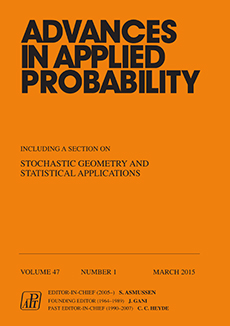Abstract
Let N and M be positive integers satisfying 1≤ M≤ N, and let 0< p0 < p1 < 1. Define a process {Xn}n=0∞ on ℤ as follows. At each step, the process jumps either one step to the right or one step to the left, according to the following mechanism. For the first N steps, the process behaves like a random walk that jumps to the right with probability p0 and to the left with probability 1-p0. At subsequent steps the jump mechanism is defined as follows: if at least M out of the N most recent jumps were to the right, then the probability of jumping to the right is p1; however, if fewer than M out of the N most recent jumps were to the right then the probability of jumping to the right is p0. We calculate the speed of the process. Then we let N→ ∞ and M/N→ r∈[0,1], and calculate the limiting speed. More generally, we consider the above questions for a random walk with a finite number l of threshold levels, (Mi,pi) i=1l, above the pre-threshold level p0, as well as for one model with l=N such thresholds.
Citation
Ross G. Pinsky. "The speed of a random walk excited by its recent history." Adv. in Appl. Probab. 48 (1) 215 - 234, March 2016.
Information





